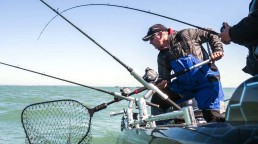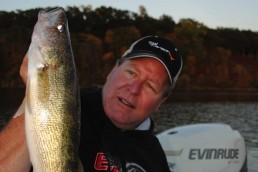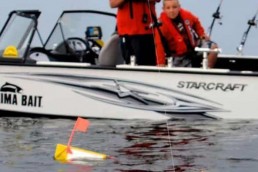Trolling Tricks: Down and Out for Walleyes
SHARE THIS POST
Football and walleye fishing are two of our passions, and there are a lot of common themes and strategy between the two. It begins with preparation and studying your opponent. As game time approaches, last-minute changes in strategy are made based on different factors.
Trolling for walleyes is like a quarterback spreading the receivers out, leaving options open for a short pass with a quick-hitch route or for going long to stretch the opponent. Once you see what is working, it’s just a matter of making adjustments to outsmart the other side before or after they try to counter your moves. Planer boards are like the receivers. Without these mobile, agile aids we wouldn’t be able to effectively spread out our lines and cover a larger area of water. Situations where walleyes can be easily spooked are perfect for using planer boards. In crystal-clear water, your planer boards help move the baits away from the boat. When walleyes are in shallow water, the boards allow you to put your lures in the right “red” zone while the boat remains in deep water.
Another bonus is the ability to work a gradual break by running some lines in shallower water and some lines in deeper water at the same time. Open water is ideal for planer boards too. Here, fish will often suspend and are easily spooked by a boat. By running several boards out each side of the boat, not only does it reduce spooking, but it also creates a wider swath of trolling coverage.
Once we have spread our lines out from the boat we have to put our lure in the right spot within the water column. If fishing structure, we will want to be on the bottom. And if we are fishing an open-water basin, we will want to have our baits at or above where we are marking fish.
Often, weights are needed to help get the bait to the proper place in the water column. We like to use Off Shore Tackle’s Tadpole Resettable Diving Weights (Model OR36). We often pair these weights with spinners, also known as ‘crawler harnesses. These weights not only sink, but they are also able to dive due to their unique “tadpole-like” shape, which allows us to use shorter leads. A shorter lead is more efficient when reeling in a fish, and is less likely to drop to the bottom as a result of a boat surge caused by waves. If a boat pauses, the shorter leads will all help keep the Tadpoles from swinging down too quickly, making them less likely to bang the bottom and get snagged.
We really have to watch our speed to get into the exact zone. Changing speed can also be our friend. If we mark fish higher than where our baits are we can then adjust the bait depth by simply speeding up.
Are you enjoying this post?
You can be among the first to get the latest info on where to go, what to use and how to use it!
Running multiple boards out each side of a boat begins with rod placement. In the back, we put three rod holders on each side. The rod with the “outside line” is in the rod holder farthest from the front of the boat and the “middle line” will go in the middle rod holder. The “inside line,” which is the line with the board closest to the boat, will be placed in the rod holder at the back of the boat. The rod holder at the front of the boat should be pointed up high. The next one should be at a medium level and the back one should be pointed just above the water. This setup gives the rod tips separation, which will reduce the chance of tangled lines.
It is important to have durable rod holders. There is a good amount of torque due to the weight of an inline weight or a crankbait pulling, and, of course, the pull of the board. Rod holders should also be easy to adjust up and down.
For planer boards, we’ll use Off Shore Planer Boards (Model OR12). While the standard board comes with two clips, we like to add a Snapper Release (Model OR18) on the main arm. The Snapper can securely lock any line, so slippage is never a problem. You want planer boards that are perfectly ballasted so they won’t flop in waves and can be pulled really slow for spinners or fast with a lot of weight behind them.
We run at least two boards on each side of the boat (If fishing in Minnesota, only one is legal.) Multiple boards allow us to compare how they are running. If we don’t have something to reference against, it can be hard to tell if we have a small fish or weed on our lure. On the standard setup when a board slips back, something is on—hopefully a fish.
Use flags that have a spring system that pulls the flag down when extra weight is on a line, such as small fish, weeds or a big walleye. Tattle Flag makes a system where the tension can be adjusted by moving the spring to different locations on the board based on the pull of the bait being used. Adjust it so the flag just barely stays up; any additional pull will snap the flag down. Some newer flags this year may allow you to put proper tension on a flag for pulling a lot of weight, such as heavy-pulling cranks, weights with crankbaits and even leadcore.
As you prepare for your next walleye trip, study the lake and create a playbook. Send your “receivers” down and out, spread the boards and adjust to the proper depth so you can score on your next bite.
MWO
SHARE THIS POST
Did you enjoy this post?
You can be among the first to get the latest info on where to go, what to use and how to use it!
Parsons/Kavajecz
Gary Parsons and Keith Kavajecz are professional walleye anglers specializing in tournament fishing and walleye fishing promotions. Both are “Legendary Angler” inductees into the National Fresh Water Fishing Hall of Fame, accomplished authors and co-hosts of the popular The Next Bite TV show. For more info: thenextbite.tv.



